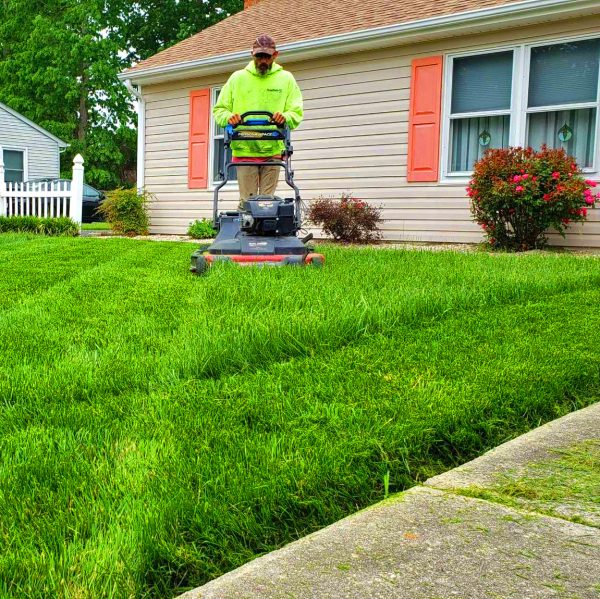What does fertilizer look like? One of the most common questions that professional turf management companies are asked by their clients relates to the uncertainty that a scheduled service was actually performed or applied. Fertilizer for grass can vary widely in terms of appearance, especially where organic fertilizer is concerned, and when considering the differences between liquid fertilizer and granular fertilizer.
When a professional turf management company visits a client’s property to perform a fertilization service, the best companies will first knock on the client’s door in case someone is home to alert them that they are on the property and answer any questions the homeowner may have about the lawn. When the applicator is done servicing the property, they will often leave information about the service hanging on the door as well as place a sign in the yard to let homeowners and neighbors know that the lawn has been treated. This is the straightforward way in which most fertilizer companies assure their clients that a service was indeed performed.
Unfortunately, as with any industry and service, there are always the rare circumstances in which a service is not performed as it should be. With the rise of residential security cameras, there is more ability for a homeowner to verify a “ghosting” situation, and this is good in that it requires accountability from service providers. However, it has also bred a degree of mistrust for the industry that honest companies battle every day in the field.

In most situations, it is very difficult to actually see that any fertilizer for grass areas of the yard was applied to a property, which is why it’s good for clients to ask, “What does fertilizer look like?” This can be for one or more of several reasons:
The product is in liquid form: Obviously, if liquid fertilizer or weed control is sprayed on a lawn, it will not be easy to identify unless the lawn is still wet. Unless a liquid product is dyed, a homeowner is very unlikely to see any kind of residue.
The product is organically based: Granular fertilizer can still be difficult to see. Synthetic prills are often a bright color with the purpose of visibility, but more and more fertilizer products are embracing an organic foundation. As a result, they are very often a shade of brown that blends in greatly with the yard’s soil.
The lawn is thick: Granular fertilizer comes in small, roughly spherical prills that can range in size from something comparable to sand up to something comparable to peas. There is a lot of science that goes behind how coarse a granular fertilizer is, but it’s always meant to fall into the turf and reach the soil surface where it can break down and do what it’s meant to do. As a result, a lot of searching through the grass would be necessary to get deep enough to see where the fertilizer has landed.
The applicator is trained well: That is right, a good applicator does not want you to be able to see the product they have applied! This is not for any sneaky reasons, but for responsible ones. The places you are most likely to see remnants of a lawn treatment are on hard surfaces around the property such as curbs, driveways, sidewalks, or deck stairs. With liquid fertilizer, a good applicator treats just up to these areas, but avoids spraying more than just the edge where they meet the lawn. With granular fertilizer, a good applicator carries a blower or broom on their truck so that any pellets that land on these surfaces can be pushed back into the lawn.
There are two reasons for this being the standard of care expected at a property. First, all materials being used on a lawn have value, and it is wasteful to apply them to an area like a driveway that in no way is meant for growing grass! Second, and most importantly, Any product left on these surfaces has a high risk of running off with the next rainfall and entering a community’s waterways. A vital part of a turf management professional’s job is to reduce the environmental impact their treatments have as much as possible.
The question “What does fertilizer look like?” does not have a straightforward answer because there is so much variety in the way that fertilizer is delivered and what makes it up. What’s most important to know is that it is almost always going to be difficult to see within the lawn once it has been applied. As a result, homeowners should always work with a company for their lawn care with which they feel confident and with which they can communicate about their services.








Sorry, comments are closed for this post.